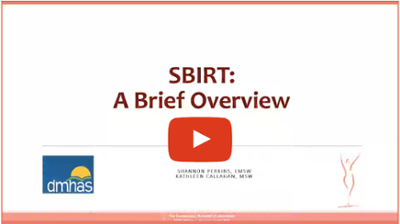What Is SBIRT? And How Does It Help Address Substance Use Disorders?

When clients appear to be struggling with substance use issues, behavioral health professionals often use a tool called Screening, Brief Intervention & Referral to Treatment (SBIRT) to help identify, reduce, and prevent problematic substance use, abuse, and dependence.
What Is SBIRT? And how can behavioral health professionals use this screening tool to help people who are at risk for substance use disorders?
What Is SBIRT?
Screening, Brief Intervention & Referral to Treatment (SBIRT) is a comprehensive, evidence-based public health practice for early intervention.
The Substance Abuse and Mental Health Services Administration (SAMHSA) recommends this approach when primary care centers, emergency rooms, trauma centers, and other clinicians work with people with identified substance use disorders or with those who are at risk of developing these disorders.
SBIRT identifies, reduces, and prevents problematic substance use, abuse, and dependence by helping providers to identify problematic substance use. It assesses the risks for physical and emotional health problems, disease, injuries, poor job performance, and family and social problems. The goal of this public health approach is to help decrease the impact of substance use issues and identify the person’s willingness to address them.
SBIRT Components
The SBIRT includes three main components.
- A screening to quickly assess the severity of substance use and identify the appropriate level of treatment.
- A brief intervention that focuses on increasing the person’s insight and awareness about substance use and identifying their motivation for behavioral change.
- A referral to treatment if the screening shows they need more extensive treatment and/or access to specialty care.
Harm Reduction and Healthy Choices
 This CWC video explores the use of SBIRT, breaking down the service delivery components of the tool.
This CWC video explores the use of SBIRT, breaking down the service delivery components of the tool.
- Screening is a method for identifying a person who is at risk for substance misuse.
- Brief Intervention is a low-intensity, short conversation with someone who screens positive. It should happen right after the screening to build commitment to change through Motivational Interviewing techniques.
- Referral to Treatment facilitates access to specialty care when the person shows signs of more serious substance misuse or use disorders.
Many behavioral health professionals are involved in recovery-oriented systems of care, which involve a holistic, long-term, coordinated approach to treatment.
Why Is SBIRT Important?
Addressing potential substance abuse disorders is important because of the human toll of substance abuse in our society. Substance misuse has a ripple effect on families, workplaces, communities, and health care systems.
Problems connected with substance use disorder include:
- Work and school attendance and performance
- Relationships
- Legal issues
- Unwanted, unplanned, and unprotected sexual activity
- Memory problems
- Adverse effects on the reproductive system
- Changes in brain development, which can have life-long effects
- Death from overdose or alcohol poisoning
Screening Is Critical
Screening does not diagnose, but it does help to determine the severity and risk of a person’s substance use. If we don’t ask, we don’t know.
The SBIRT is a chance to assess how much substance use is interfering with a person’s daily functioning and relationships. It provides valid, self-reported information that can be used for feedback. Importantly, it also gives clients a chance to reflect on their own substance use, setting the stage for the next steps. SBIRT utilizes one of the following valid screening tools.
- CAGE-AID (one of the most common quick screening tools)
- NIAAA 3-Question Screen
- AUDIT
- ASSIST
- S2BI ( a tool for screening teens)
- CRAFFT (for ages 12-21)
The CAGE-AID Questionnaire
One of the most common screening tools is called CAGE-AID. It includes just four simple questions.
- Have you ever felt that you ought to cut down on your drinking or drug use?
- Have people annoyed you by criticizing your drinking or drug use?
- Have you ever felt bad or guilty about your drinking or drug use?
- Have you ever had a drink or used drugs first thing in the morning to steady your nerves or to get rid of a hangover (eye-opener)?
The letters AID stand for “adapted to include drug use.”
Two or more yes answers on the CAGE-AID is considered clinically significant.
When You Have a Positive Screen
A person’s answers to the screening questions will determine the next steps. In almost 70% of cases, people will be identified as abstainers or low-risk drinkers. That’s an opportunity for the clinician to reinforce the positive screen and perhaps provide information about the hazards of increased substance use.
Approximately 25% of people will screen as risky drinkers (or substance users). That’s when it’s helpful to provide clients with information about the risks of substance use and help them to strategize ways to decrease consumption.
In approximately 5% of people, the screening will show alcohol dependence. Clinicians should set up a clear process for follow-up or refer them to an appropriate treatment program.
Any level of substance use is risky for adolescents. However, SBIRT is a harm reduction model and not an abstinence model.
Learning More about Prevention and Treatment
For clinicians seeking to learn more about using SBIRT and Motivational Interviewing to address the use of drugs and alcohol, CWC’s SBIRT training offers an opportunity to explore SBIRT and incorporate the model into their practice.
It is also important to understand the ways that alcohol, nicotine, opioids, and other substances affect people’s brains and development.
These harm reduction and treatment-focused approaches can help identify and treat substance use issues before they cause further harm to our families and communities.
Subscribe for blog updates -
Subscribe for updates
_.webp)



